The world is filled with beetles of all colors, shapes, and sizes. It is not always easy to identify a beetle you may have found in your home or garden.
We have comprised a list of the most common beetles you will encounter in California, helping you identify them with ease. Continue reading below to find out more.
Table of Contents
1. Convergent Ladybug
The Convergent Ladybug (Hippodamia convergens) is one of the most common ladybird beetles you will encounter in California.
This beetle is native to North America and has established itself in South America by importing them from California.

Female convergent ladybugs can lay up to three hundred eggs over a few months. They lay their eggs during spring and summer. The larvae look similar to alligators and can grow four times their size over one month.
The pupal stage lasts a week and the beetles mate as soon as the adult ladybug emerges.
2. Seven-spotted Ladybug

The Seven-spotted Ladybug (Coccinella septempunctata) is a common ladybird. They are red with three black spots on the elytra and one spot spreading over the junction of two, this creates seven spots.
This ladybug can grow to seven millimeters in length. Their colors warn of their toxicity. This makes them unappealing to predators. They secrete a fluid from their legs which makes them taste foul. They often play dead when threatened, while secreting a foul odor.
They are found throughout the world and are common visitors to gardens throughout California.
Further Reading:
3. Asian Ladybug

The Asian Ladybug (Harmonia axyridis) is a variable species with a wide range of colors. It is native to eastern Asia and has been introduced to North America. It is found in abundance in California, often referred to as the Halloween beetle.
It is a dome-shaped beetle with smooth wing coverings and a smooth head. It can grow to 8.5 millimeters in length. The common color is orange or red with up to twenty-two black spots of various sizes. They are also solid black with up to four red markings. Other forms have been reported which include solid black and patterns of orange, red, and black.
The easiest way to identify it is a large size. It is native to eastern Asia and is a voracious predator of aphids and scale insects. It has been introduced in fields, gardens, and greenhouses and has established itself in North America.
In North America, it was spread by humans and established itself. It was introduced to control the spread of aphids. It was first introduced in 1916 but failed to establish. An established population was later observed in New Orleans and Louisiana. In 1988, it spread quickly to other states and is commonly observed in California.
4. Figeater Beetle

The Figeater Beetle (Cotinis mutabilis) is also known as the green fruit beetle. It is a member of the scarab family, which is known as flower chafers. Its primary habitat includes California and Mexico.
The larvae are often called crawly backs. They roll onto their backs and move upside down. The adults grow to around three centimeters in length. They are semi-glossy green and brilliant green on their legs and bellies. They are active during the day.
This beetle is native to the moist areas of southwest America where it feeds on cacti fruit and the sap of desert trees. Their range has expanded and they are often encountered in compost piles, organic mulch, and home gardens.
5. Spotless Ladybug

The Spotless Ladybug (Cycloneda sanguinea) is widespread in California. It is found from the southern United States to Argentina and the Cayman Islands to the Galapagos Islands. This large ladybird is red and unspotted. Their colors range from deep red to orange.
There are white and black markings on the pronotum and head. Females and males have white spots on the black areas. Females have black in the center of the black area, whereas males have a white cleft just above the head. Males also have white faces.
They feed on aphids found on milkweeds. The pupae can bite predators.
6. Spotted Cucumber Beetle

The Spotted Cucumber Beetle (Diabrotica undecimpunctata) is native to North America. It is a major agricultural pest. They cause damage to crops in their adult and larval stages. Larvae feed on the roots of emerging plants causing damage to the young plants, whereas adults feed on leaves, stems, flowers, and fruits.
This beetle has three subspecies. As adults, they feed on the leaves of squash, cucumber, beans, corn, soybean, and cotton. An adult female lays eggs in the soil near the cucumber plant. The eggs take up to nine days to hatch and the larval stage is around three weeks.
Adults are green-yellow with six black spots on each elytron. They grow to half a centimeter in length.
7. Diabolical Ironclad Beetle

The Diabolical Ironclad Beetle (Phloeodes diabolicus) is commonly seen in desert areas, where they live on fungi growing below the tree bark. This flightless beetle lives for around two years. It is a durable beetle with dense layers and interlocking elytra.
These beetles have a flat shape and are low to the ground. It makes them very difficult to squash. The compression is spread across the shell, evenly disturbing any force over the entire shell. They layer multiple scales of various sizes to provide their mechanical strength. It can endure forces more than thirty-five-thousand times its body weight.
8. Ten-lined June Beetle

This beetle (Polyphylla decemlineata) is also known as the watermelon beetle and is a member of the scarab beetle family. They are attracted to light, feeding on foliage. They make a hissing sound when touched or disturbed.
They are agricultural pests for numerous crops. The larvae feed on the roots of plants, weakening or killing the plant. They are large beetles and grow to three centimeters in length. The males have distinctive antennae made up of numerous plates. There are four white stripes and one short stripe on each wing cover.
Further Reading:
9. California Ladybug

The California Ladybug (Coccinella californica) has red wing covers that are spotless and a black thorax. They are commonly seen in the coastal areas and north to the Transverse Ranges. These beetles can be red or orange and there are no spots, there is a black suture where the wings meet in the center of the back.
In some cases, the black suture is a diamond-shaped patch at the base of the wings. The pronotum is black with a white patch on both sides. The head is black with two white spots between the eyes.
10. Woolly Darkling Beetle

The Woolly Darkling Beetle (Eleodes osculans) is a ground beetle and is common in coastal southern and central California. They are found in wooded areas of chaparral and Baja California. They have a distinct defense posture, raising their hind end and secreting a foul odor.
They grow to just over one centimeter in length and have red-brown hair on its back. The larvae can be found in dry soil and in plant litter where they feed on detritus.
11. Eleodes acuticauda

This desert stink beetle is found in southwestern North America. The pronotum is twice the width of the head and is very strong. It has projections on the anterior corners. There are spines on the first pair of legs and they have broad heads.
They are very common in Los Angeles in Southern California.
12. Armored Stink Beetle
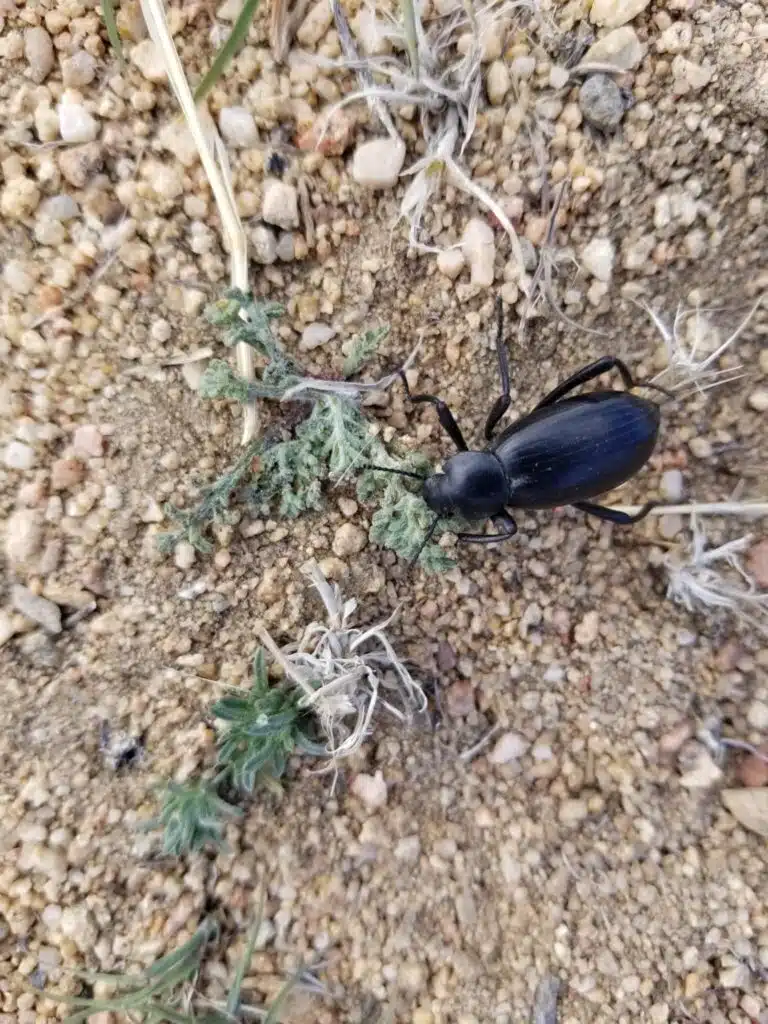
The Armored Stink Beetle (Eleodes armata) is found in the western United States and Mexico. It is commonly encountered in California where it prefers warm, dry regions. This stink beetle can grow to three centimeters in length.
They are active throughout the year. This is a nocturnal beetle during the summer months and is active during the day in cooler weather.
13. Ornate Checkered Beetle

The Ornate Checkered Beetle (Trichodes ornatus) is only found in North America. Larvae live in bee nests and are parasitic. They feed on the bees’ larvae and pollen.
As adults, they feed on milkweed and other yellow plants. Males grow to eleven millimeters in length and females grow to fifteen millimeters in length. As adults, the beetle resembles a bee. They are black and yellow with black heads and legs.
14. California Root Borer Beetle

The California Root Borer Beetle (Prionus californicus) belongs to the longhorn beetle family and is native to America. It is a pest to vine crops and orchards. This beetle can grow to 5.7 centimeters in body length.
They are red-brown with shiny wings. They emerge from the soil from June to August. Males are smaller than females with aerated antennae. They are nocturnal with males being more active.
The cream to brown larvae is segmented and feed on plant roots, tunneling through the root. They are serious pests, often killing the plant. The larvae move from small-diameter roots to larger ones as they grow. As adults, they do not feed.
They are orchard pests and are serious pests to fruit trees in the Intermountain West region.
15. Bronze Beetle

The Bronze Beetle (Chrysolina bankii) is a leaf beetle species native to Europe and the western Mediterranean Basin. It has been introduced to the United States with an expanding range, that includes California.
This large beetle grows to over ten centimeters in length and is metallic bronze with brown-orange legs. There are puncture marks on the elytra. Their diet comprises leaves.
16. Varied Carpet Beetle

The Varied Carpet Beetle (Anthrenus verbasci) is a small beetle that grows to three millimeters in length. They are common pests in California. They can be found in homes and museums, where the larvae cause damage to clothing, furniture, and carpets.
They have rounded bodies with fine scales on the pronotum and elytra in various colors. This creates a pattern of yellow, brown, and white. The white scales are on the lateral margins of the pronotum and the elytra.
The larvae are known as woolly bears and grow to five millimeters in length. They are elongated and covered in hair.
17. Australian Tortoise Beetle

The Australian Tortoise Beetle (Trachymela sloanei) is a small beetle, native to Australia where it lives on Eucalyptus trees. It is an invasive pest throughout California.
This beetle can grow to seven millimeters in length and feeds on Eucalyptus causing considerable damage. It was first recorded in California in 1988.
18. Twenty-spotted Ladybug

The Twenty-spotted Ladybug (Psyllobora vigintimaculata) can grow to three centimeters in length with up to four distinct spots on the pronotum that forms an “M” shape. The elytra have bi-colored or orange spots on a white background.
When the larvae first hatch they are white with small hairs on the thorax. In the second instar, they have a dark stripe and by the end of the fourth instar, they attach to a leaf and molt. The pupae emerge with black spots and wing pads.
There are reports that this ladybug could be used as biological control, rather than using fungicides.
19. Brown Leather Wing Beetle

The Brown Leather Wing Beetle (Pacificanthia consors) is common in California. They grow to just short of two centimeters in length. These beetles are orange and have brown wing covers. The legs are red with black markings.
This beetle is attracted to artificial lights and you will likely encounter one at some point. It is not a harmful species. The larvae are nocturnal, hatching the spring, and can be found under rocks, bark, and in leaf litter. It takes approximately one year for the larvae to emerge as adults.
20. Western Polished Ladybug

The Western Polished Ladybug (Cycloneda polita) is also known as the western spotless ladybird. It is common in California with red elytra without any spots. They have a black thorax with white rim and crescents.
In California, you are likely to encounter this ladybug from March to November.
21. Coyote Brush Leaf Beetle

The Coyote Brush Leaf Beetle (Trirhabda flavolimbata) is found along the coast of the San Francisco Bay area. Its primary host is the coyote bush. It also feeds on Aster and other plants. Adults are active from April to May.
These are small beetles that grow to six millimeters in length. They live and feed on the coyote bush, a perennial shrub.
22. Spined Woodborer
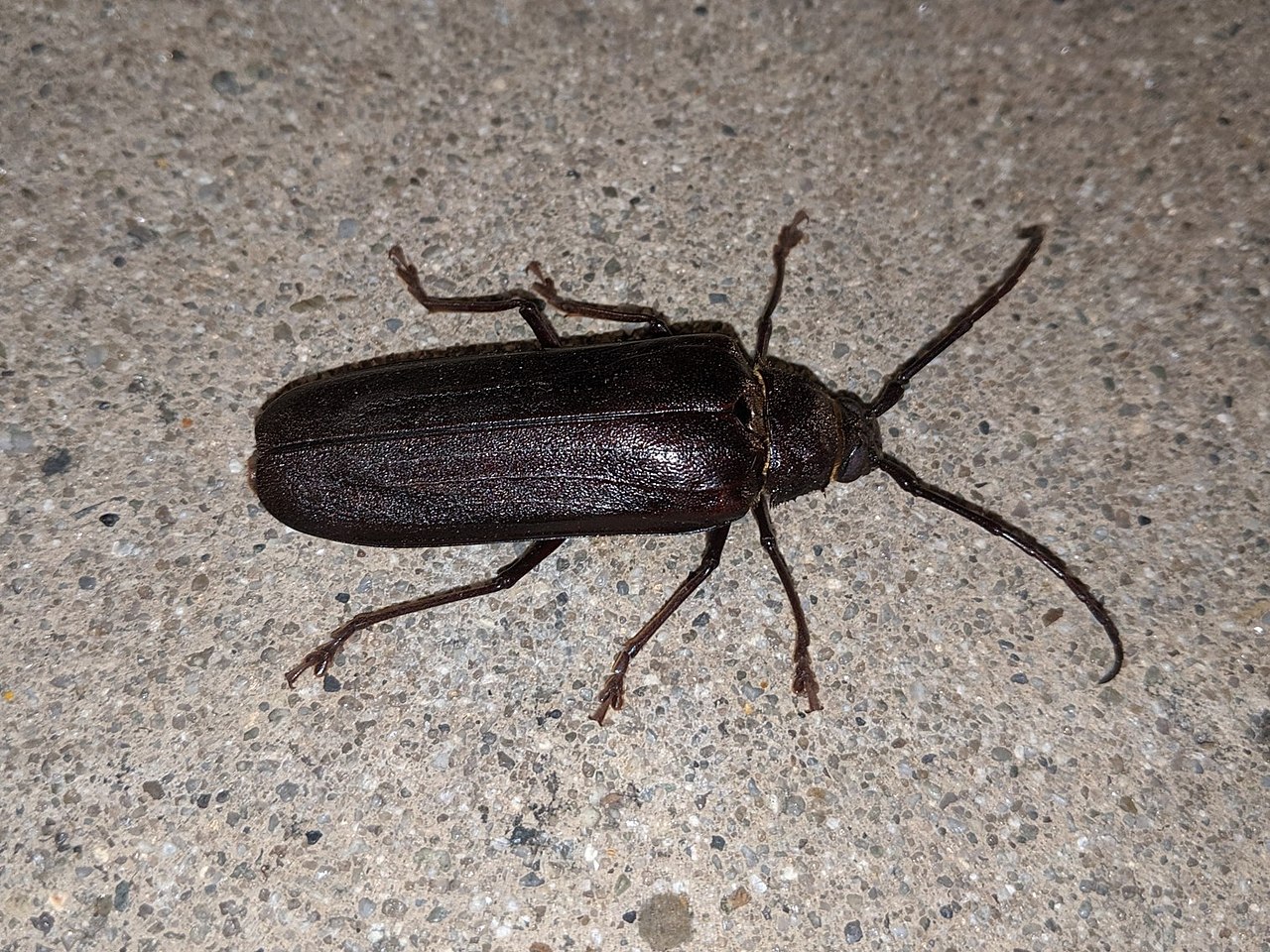
The Spined Woodborer (Trichocnemis spiculatus) larvae chew into the wood. The good news is that the eggs are only placed on cut logs and fallen trees, therefore they do not cause problems in healthy trees. The problem does come in that people use felled timber for flooring, furniture, log homes, and fires, transporting these beetles into the home.
This large brown beetle is not aggressive. It has powerful jaws that chew through wood and can give a painful bite if they are threatened. They have long antennae. You are likely to see the beetle walking rather than flying.
23. Master Blister Beetle

The Master Blister Beetle (Lytta magister) or the Desert Blister Beetle is found in southwestern North America. They grow to just over three centimeters in length with red heads and legs, and black elytra.
They are often found in large numbers during the spring and tend to swarm. The larvae are insectivorous, attacking bee nests. The larvae feed on immature bees and provisions. They are food parasites and not parasitoids.
As adults, they feed on the leaves and flowers of the brittlebush.
24. Inflated Beetle

The Inflated Beetle (Cysteodemus armatus) is a Blister Beetle with are black with white spots. The elytra are fused in the middle. These beetles cannot fly. They are commonly encountered from February to June.
As adults, they feed on a host of plants, while larvae feed on bees.
25. Cobalt Milkweed Beetle

The Cobalt Milkweed Beetle (Chrysochus cobaltinus) has an iridescent blue exoskeleton. They grow to eight millimeters in length with an oval body. They are similar to click beetles and can jump a few times the length of their body in a single jump.
The adults and larvae feed on milkweed and dogbane. As adults, they feed on the flowers and foliage of newly-developed plants. In large groups they can consume the majority of leaf tissue, causing serious damage to the plant.
Adults bore holes in the leaves. The adults emerge in early summer and feed on the plants for six weeks. Females lay their eggs in the leaves and the larvae consume the leaf tissue between the veins, leaving only a skeleton.
26. Western Tiger Beetle

This (Cicindela oregona) is a ground beetle native to North America. There are numerous color forms of this species. Adults grow to thirteen millimeters in length. The adults and larvae feed on other insects.
They can be found in sandy soil not too far from water.
27. Fuller’s Rose Weevil
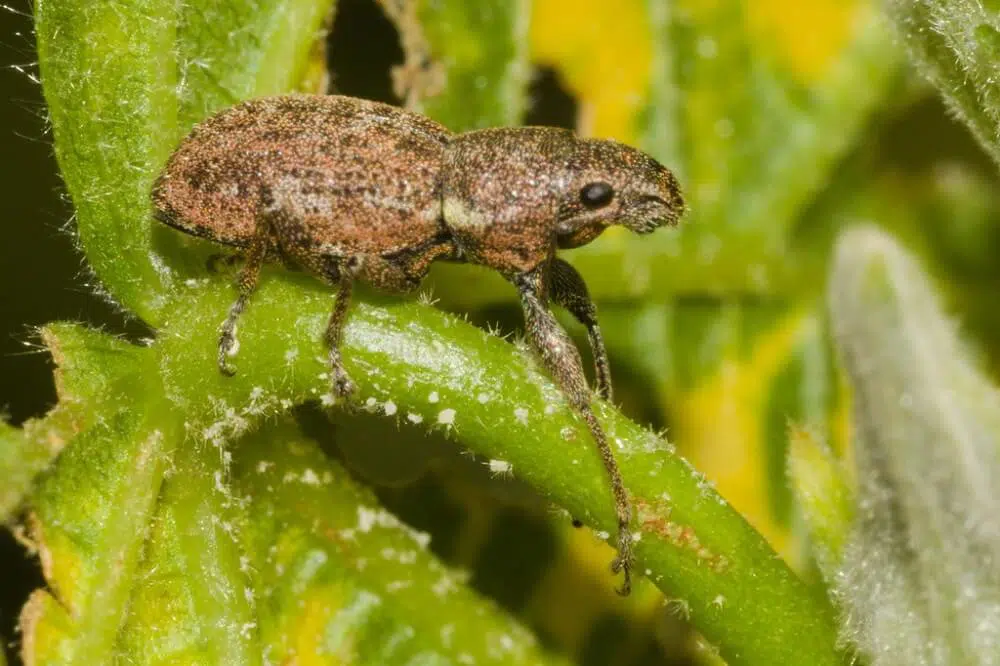
The Fuller’s Rose Weevil (Pantomorus cervinus) causes considerable damage to winter roses. It was first reported in California in 1879. Damage has been reported on other ornamental plants including primroses, begonias, citrus crops, geraniums, and apricots.
This is a brown-gray beetle that grows to just over eight millimeters in length. The snout is curved towards the ground. The elytra are fused and the beetle cannot fly. The eggs are cylindrical and yellow. They are laid in a mass, covered in white sticky material.
The larvae are white and legless with yellow heads. When the larvae are fully grown they can reach up to twelve millimeters in length.
28. Ashy Gray Ladybug
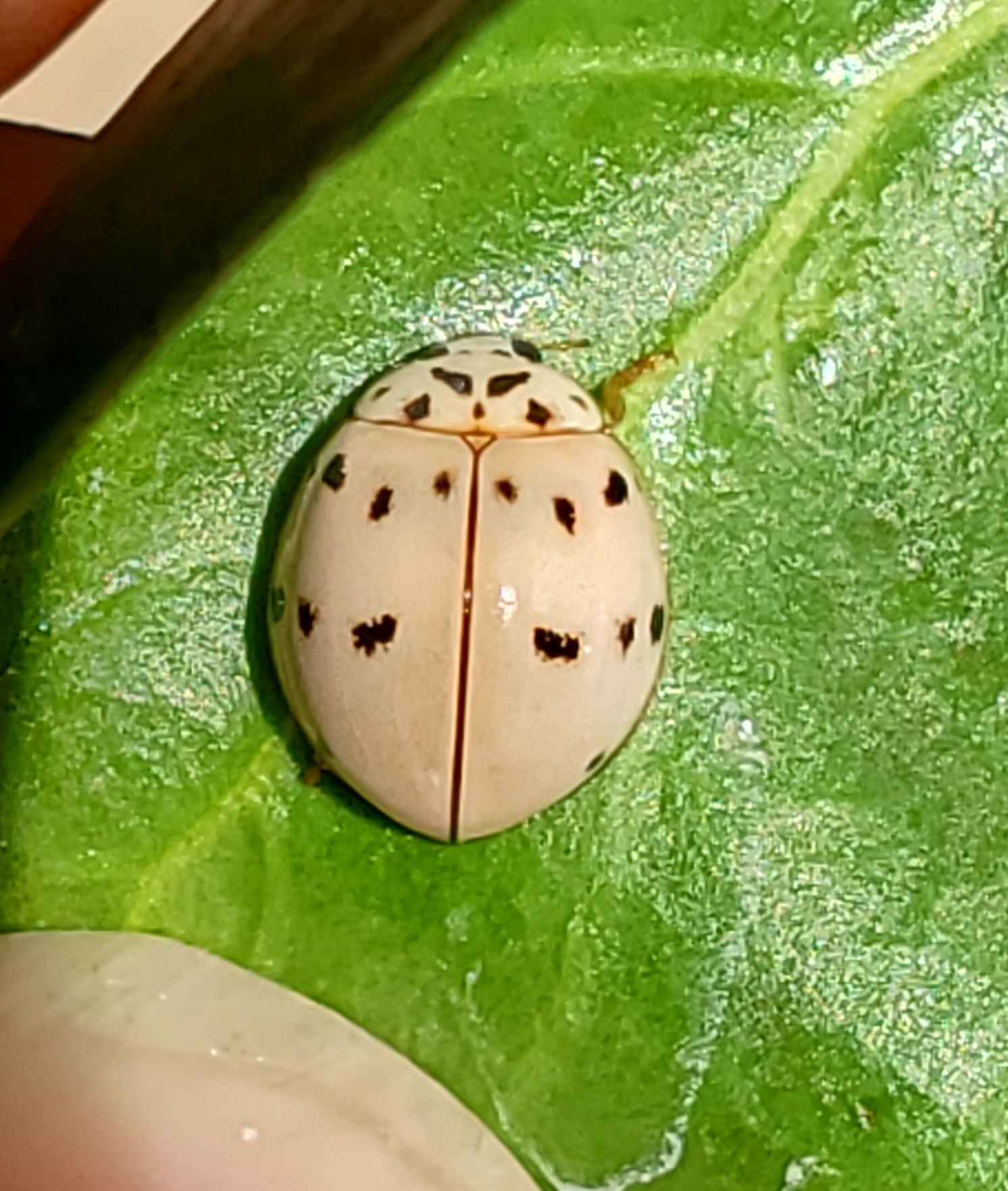
The Ashy Gray Ladybug (Olla v-nigrum) is gray or pale tan with black spots on the thorax and elytra. There are variations and some are black with red spots on the wing covers. This ladybug can grow to just over three millimeters in length.
As adults, they have a spiky appearance. The black larvae are tubular with spikes on their back. They have yellow dashes and dots. The pupa is encased in a cocoon and fixed under leaves for one week before the mature beetle emerges.
The adults have a two-year life span and can be seen in cities, near river beds, grasslands, and forests. It is not uncommon to see one of these ladybugs as they tend to overwinter in buildings.
29. Three-lined Potato Beetle

The Three-lined Potato Beetle (Lema daturaphila) originates from North and Central America. They have spread to other regions. The adults grow to eight millimeters in length. They are bright yellow-orange with lined elytra. There is a line along the suture between the wings.
They are commonly found on plants in California and are considered agricultural pests. They can cause severe damage to potato and tomato plants. The larvae feed on the host plant in groups after hatching in June. The larvae are covered in excrement to protect them from predators.
30. Little Bear
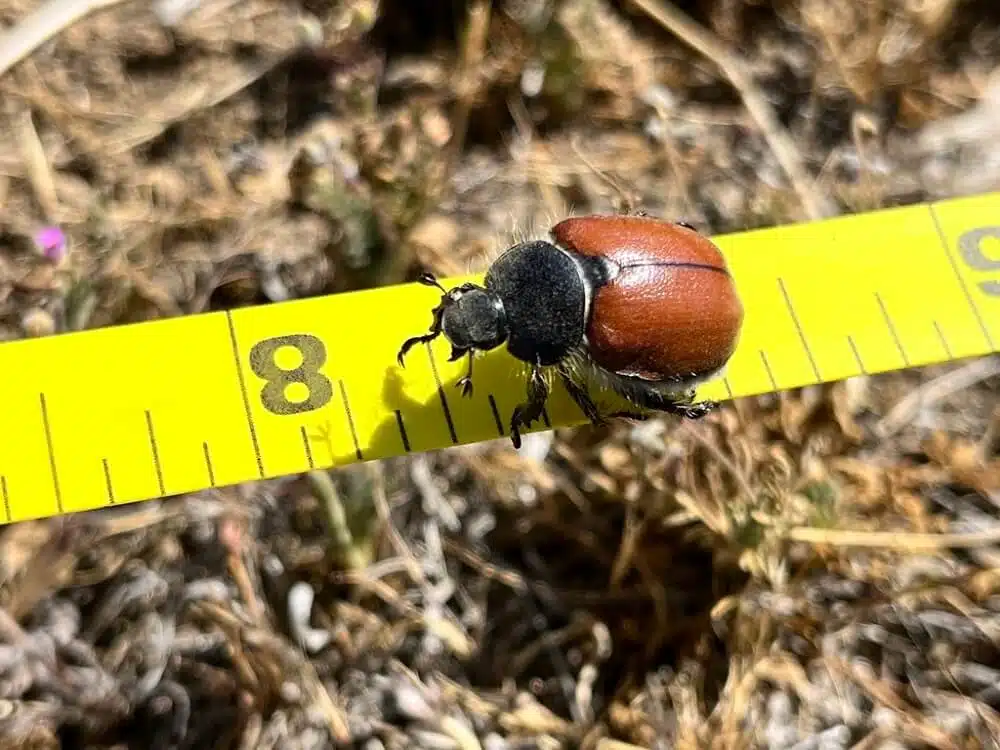
The Little Bear Beetle (Paracotalpa ursina) has a fuzzy appearance. It is a scarab beetle and can be recognized by its oval body with a black thorax and head. The elytra are red and they are covered in hair.
As adults, they feed on the flowers and leaves of herbs, trees, and shrubs. The larvae feed on the roots of shrubs. They are common in January and are seen flying among shrubs.
31. California Glowworm
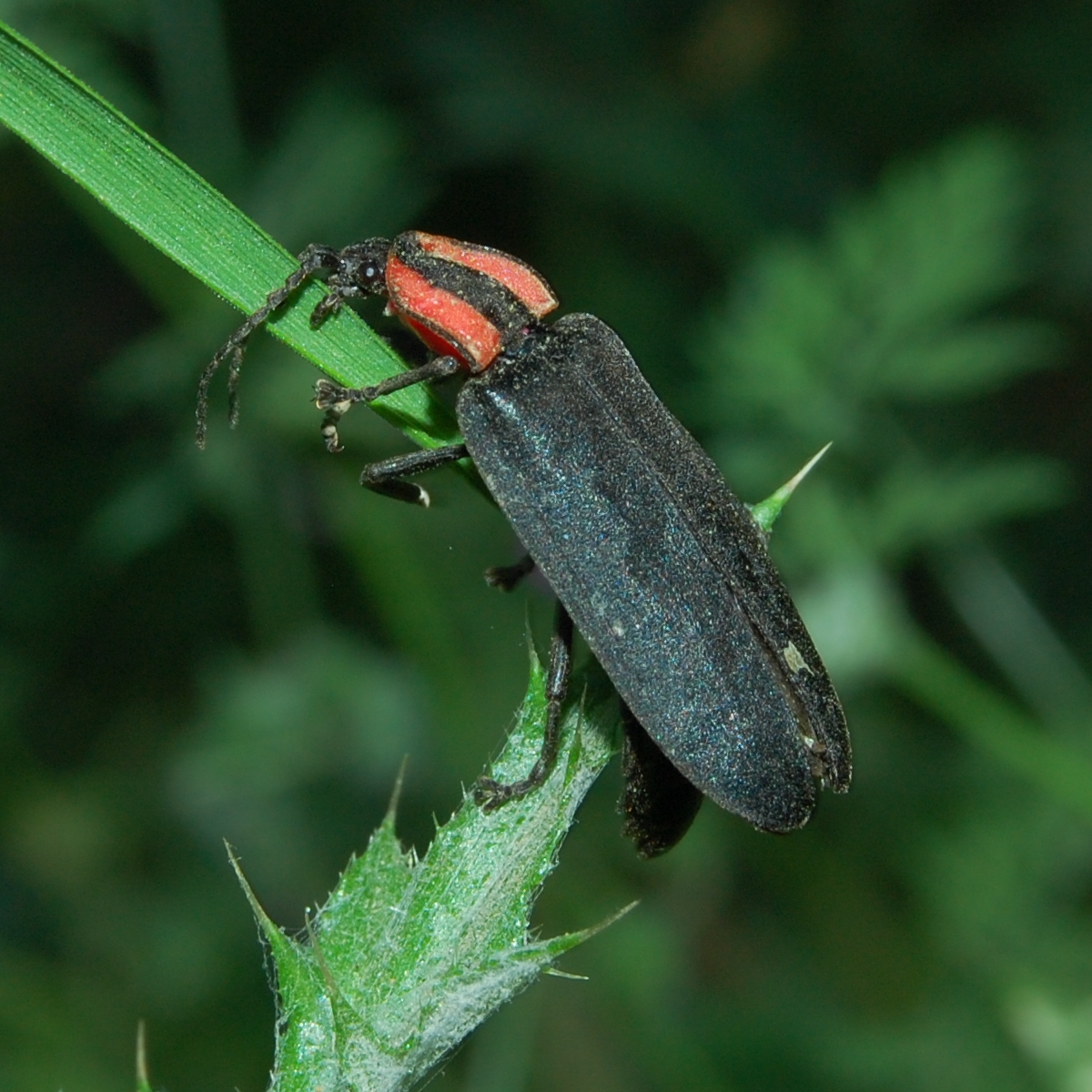
The California Glowworm (Ellychnia californica) is also known as the western firefly. They are often seen on willows and redwoods. This beetle can grow to sixteen millimeters in length.
They have black areas on the side of the pronotum. They have red on their heads and elongated bodies. They can be found throughout California but tend to be more common from the San Bernadino Mountains to the south of Sacramento.
They prefer moist habitats and can be seen on flowers and grassy vegetation during the day.
32. Downy Leather-winged Beetle

The Downy Leather-winged Beetle (Podabrus pruinosus) is a soldier beetle that belongs to the Cantharidae family. Adult beetles grow to fifteen millimeters in length. They are orange with back-brown wing covers. The wing covers are covered in hair. You are likely to encounter this beetle in spring and summer, feeding on aphids.
When threatened they fall to the ground. The larvae grow to twenty millimeters with dark lines on the thorax. The larvae live in the soil.
33. Red-eared Blister Beetle

Red-eared Blister Beetles (Lytta auriculata) can often be encountered in California. They are found in both North America and Central America.
These beetles grow to just under two centimeters in length and are commonly encountered from February to July.
34. Cosmopolitan Ground Beetle
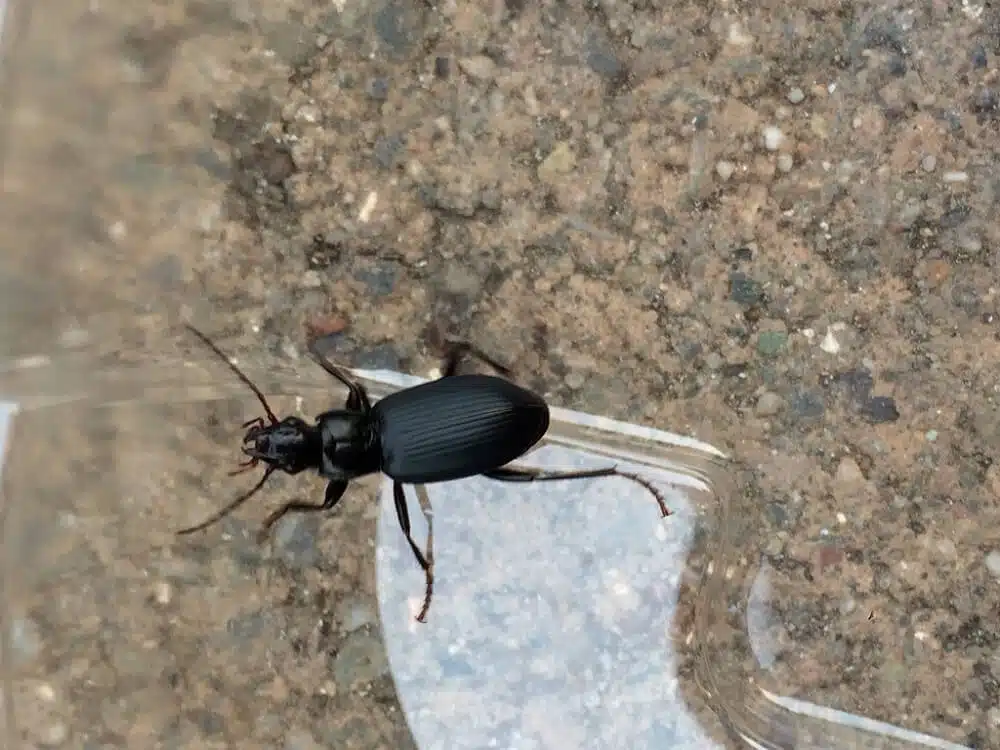
This ground beetle (Laemostenus complanatus) is native to Europe and is often found in large colonies. They are primarily carnivorous and have been introduced to North America. In 2015, more than two thousand of these beetles were found in North America.
This beetle varies in body shape and color. The majority are black or metallic. The wing covers have ridges and are fused. This means they are unable to fly.
35. White-spotted Sawyer Beetle

The White-spotted Sawyer Beetle (Monochamus scutellatus) is a wood-boring beetle and is a threat to forest health attacking dead, dying, and weakened wood. It prefers white pine but will infest coniferous hosts.
This beetle is often mistaken as the Asian longhorned beetle. The best way to identify the white-spotted sawyer beetle is the white patch seen between the wing covers. This bronze-black beetle has a rough texture.
The females lay their eggs in trees that have phloem and thick bark. They are known to impact logging activities, degrading wood by boring holes and causing structural damage.
36. Mealybug Destroyer

This beetle (Cryptolaemus montrouzieri) belongs to the ladybird species and can be found throughout California. They can grow to six millimeters in length with a typical ladybird shape. They are dark brown and do not have spots.
The antennae, elytra, legs, and head are orange-brown. Larvae grow to fifteen millimeters and have a waxy covering. Larvae and adults feed on scale insects. Females lay their eggs in between the mealybugs’ egg sacs. Larvae feed on the eggs and young crawlers.
Adults emerge within twenty-four days with a two-month life span. They have been used as a biological control against mealybugs and scale insects. They were introduced to California in 1891 to control the citrus mealybug.
37. California Broad-necked Darkling Beetle

California Broad-necked Darkling Beetle (Coelocnemis dilaticollis) has eleven-segmented antennae with their eyes notched by a frontal ridge.
It is a large, flightless beetle with a broad neck. You will find it under loose bark in dry forested areas. They have a three-year lifespan, hibernating in small groups during the winter months.
Their diet comprises plant matter, including fungi and whole grains.
38. Dimorphic Flower Longhorn Beetle
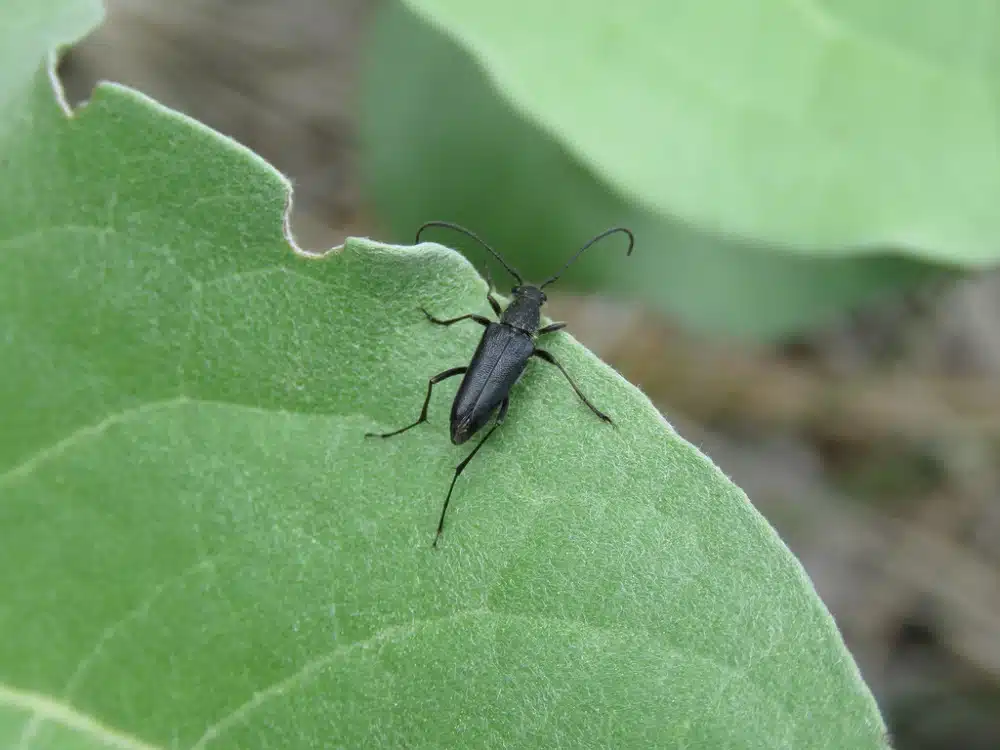
The Dimorphic Flower Longhorn Beetle (Anastrangalia laetifica) belongs to the Cerambycidae family. The males are black and the females have four black dots and red elytra. They can grow to thirteen millimeters in length and are commonly seen from April to August.
This beetle prefers chaparral and oak woodlands, along with yellow pine forests.
39. Three-banded Ladybug

The Three-banded Ladybug (Coccinella trifasciata) has a red elytra suture. There is a black band across the base of the head in the males and a pale band between the eyes. The band is not interrupted in the females.
The adult ladybug is red with a dark basal band. The pronotum is black with a white margin and ventral spot. Larvae are yellow with dark spots. This beetle can grow to five millimeters in length. They feed on aphids and soft-bodied insects.
You can see this ladybug in weeds, crops, meadows, agricultural fields, and grasses. They are active during the summer months. The female lays a cluster of pale yellow eggs that are glued to the underside of a leaf.
It takes approximately one week for the eggs to hatch and the larvae to emerge. The larvae go through four instars before they pupate.
40. Southern Masked Chafer
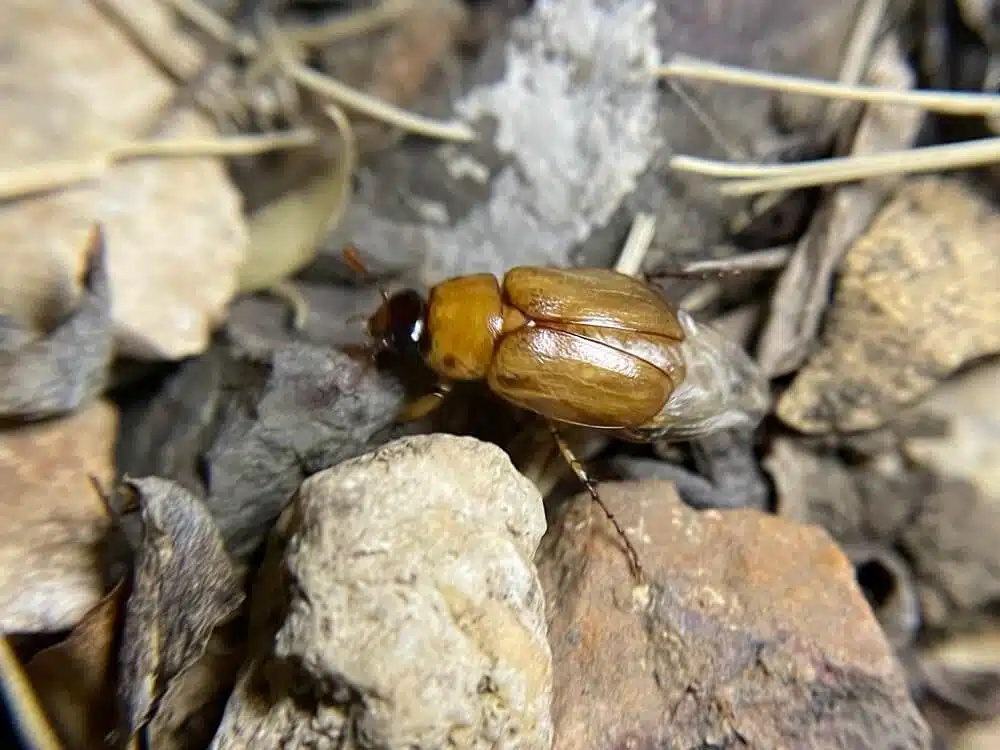
The Southern Masked Chafer (Cyclocephala lurida) is a scarab beetle, native to the southeastern United States. This is a brown beetle with a black head, growing to fourteen millimeters in length. As adults, they are not harmful, whereas the larvae feed on grass roots and can kill turf in dry conditions.
Female beetles come out of the soil after sunset in June and July. They remain on the surface, climbing up grasses. Once mated, the female returns underground to lay her eggs. The larvae feed on grass roots until late spring when they pupate.
The larvae are known as white grubs and can grow to 2.5 centimeters in length.
41. Devil’s Coach Horse Beetle

This beetle (Ocypus olens) belongs to the rove beetle family. This is a widespread beetle in California, where they have been introduced. They prefer damp areas and are commonly seen from April to October. You will find them in woodlands, parks, gardens, moorland, and hedgerows.
They hide under logs and leaf litter during the day. This long-bodied beetle grows to just over three centimeters and is black. The wind covers are short and cover half the thorax with the abdominal segments exposed. The abdomen is covered in powerful plates.
It rarely flies, though it is capable of flight. They can give a painful bite and emit a foul odor if they are threatened.
42. Golden Buprestid Beetle

The Golden Buprestid Beetle (Buprestis aurulenta), also known as the golden jewel beetle is a common sight in California. The larvae live inside coniferous trees. Adults are iridescent green with orange around the wing covers.
This is a very shiny example of the jewel beetle. While they are predominantly green, there may have purple or blue highlights. They are attracted to dead or dying trees. Females lay eggs in the bark with the larvae boring through the wood.
If a tree that contains this beetle is harvested and subjected to low humidity, the larvae are trapped and go into dormancy. Adult beetles can emerge from furniture, cutting boards, and wood paneling up to thirty years later.
43. Green Blister Beetle
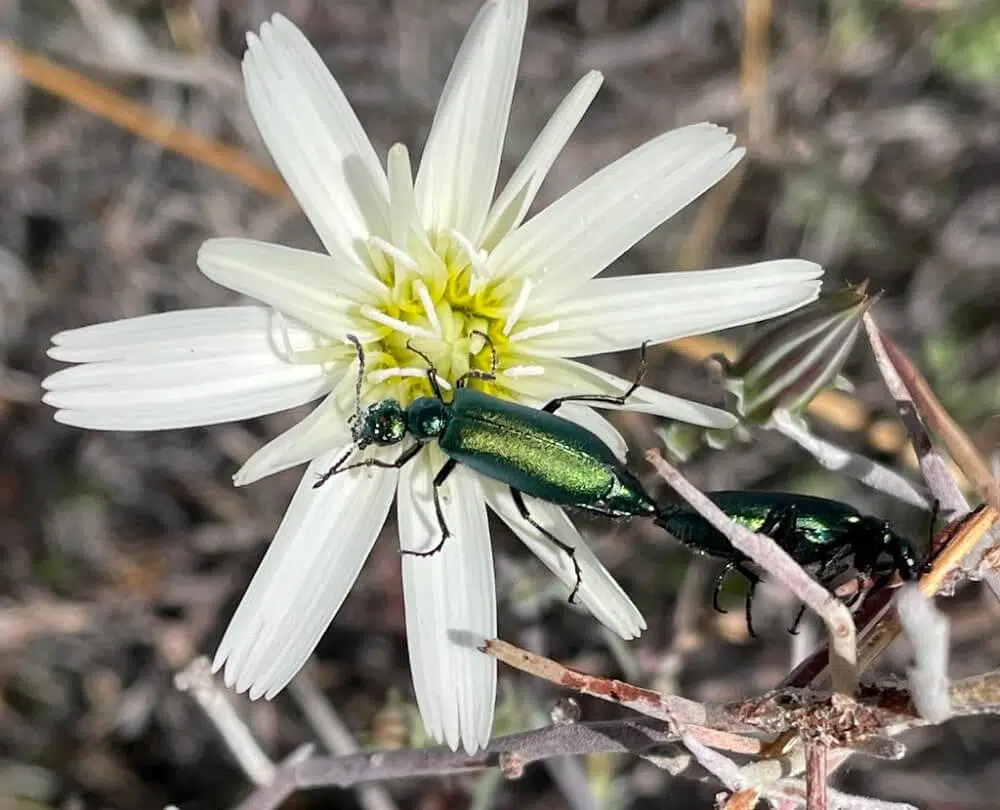
The Green Blister Beetle (Lytta stygica) is found in North America. It is a predator of the grasshopper and bee eggs. This is an active beetle and very colorful. They range from blue to green, gray, and spotted varieties.
This beetle feeds on the flowers and leaves of several plants. They emit a toxic chemical that is toxic to mammals, especially horses. This is when the horses eat alfalfa or hay that has the blister beetle in it.
They are considered pests of garden flowers, damaging the iris and showy flowers in late spring.
44. Yellow Douglas Fir Borer
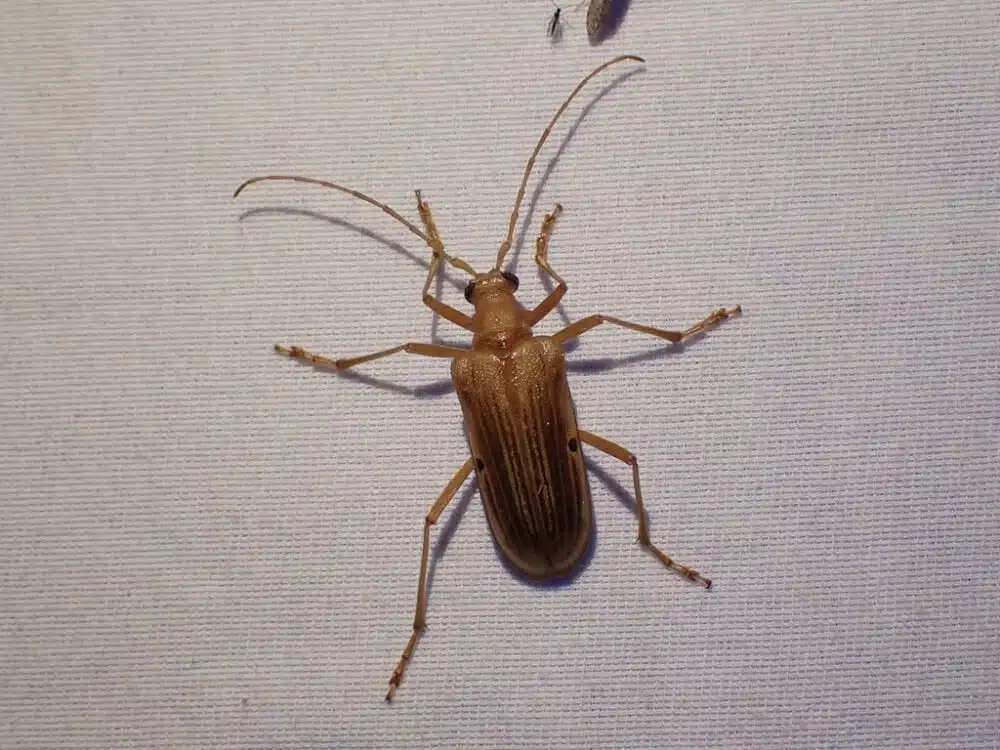
The Yellow Douglas Fir Borer (Centrodera spurca) is a flower longhorn beetle, common in North America. They behave similarly to a bark beetle, feeding under the bark. They infest dead and dying trees.
They can act as primary insects and kill healthy Douglas fir trees. They are aggressive and attack the growing Double fir, especially during droughts.
45. Eucalyptus Leaf Beetle
The Eucalyptus Leaf Beetle (Paropsisterna m-fuscum) is native to Australia and has been introduced to California, where it is considered an invasive pest species. In the forestry industry. They are a serious pest to Blue Gum in California.
This pale beetle has variable brown markings on the wing covers and pronotum. The larvae are light green, a similar color to the leaves that they consume.
This beetle was introduced in California and has invaded eucalyptus over the past ten years. They have consumed gail-forming wasps, leaf-chewing beetles, boring beetles, and psyllids.
It was introduced to California in 2003 and is not controlled by native predators. Females lay up to sixty eggs on the young foliage of the Eucalyptus plant. Hatchlings are gregarious and feed on the young foliage causing damage to the leaf edges. They are daytime feeders.
This beetle feeds on the landscape-planted blue gums in San Diego, Riverside, and Orange Counties. It is a pest to field-grown baby blue eucalyptus that is grown for foliage in northern San Diego.
The eucalyptus leaf beetle is around the size of a large ladybug. They are gray to red-brown.
46. Desert Ironclad Beetle

The Desert Ironclad Beetle (Asbolus verrucosus) is also known as the blue death feigning beetle. It is a darkling beetle native to desert areas in the southwestern United States. It adapts well to hot environments and is an omnivore, feeding on dead insects, lichen, and fruits.
This beetle feigns death when threatened. It is popular in the pet trade. They grow to twenty-one millimeters in length with bumps on the wing covers. The body is covered in a wax coating, giving the beetle a powdery blue hue.
The male beetle has red hairs on the antennae and is smaller than the females.
47. Pictured Rove Beetle
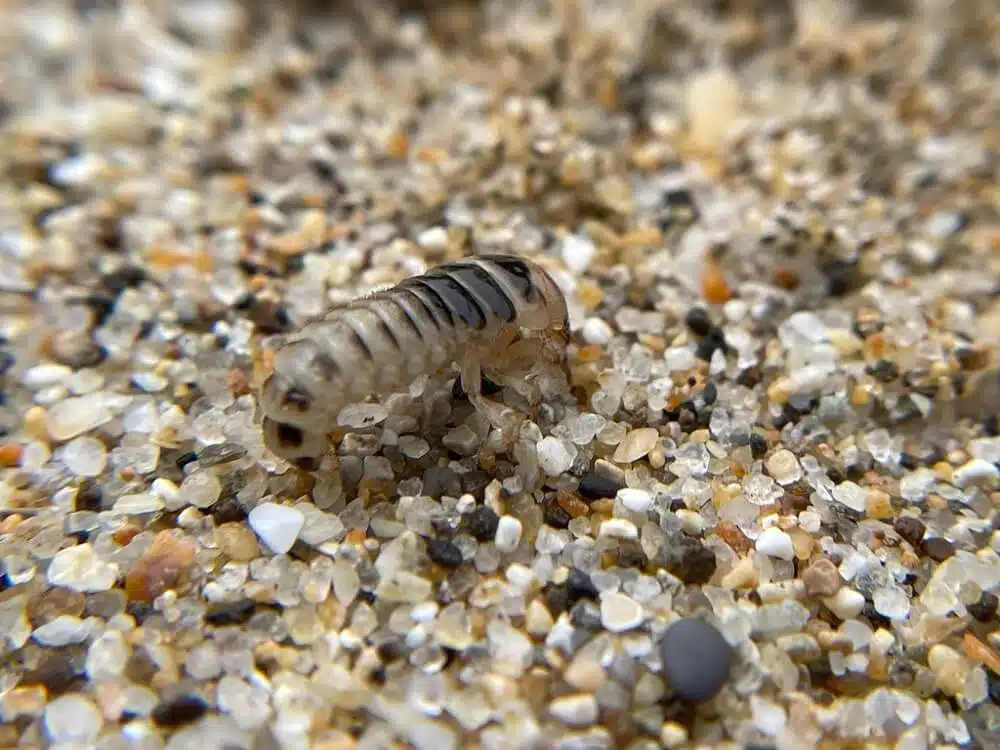
Pictured Rove Beetles (Thinopinus pictus) are wingless beetles that live on the sandy beaches of California. These are nocturnal beetles that come out at night from sand burrows, feeding on beach hoppers.
With the shortened wing covers, the abdomen is visible. The males can reach seventeen millimeters, whereas the females reach eighteen millimeters in length. Their color varies based on the color of the sand. Those found north of central California are darker due to the dark volcanic sand. Those in the south of central California are lighter.
This beetle breeds from August to October. Females lay up to three eggs. The larvae are white with black markings.
48. Stout’s Hardwood Borer
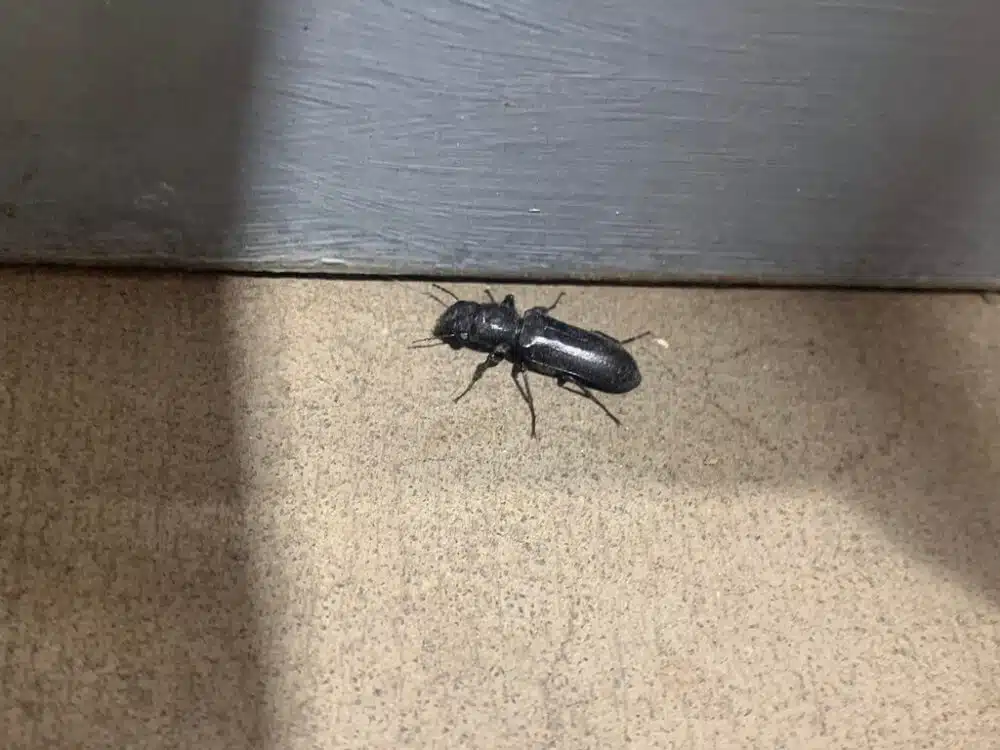
The Stout’s Hardwood Borer (Polycaon stoutii) is a wood-boring beetle found in North America. Females bore into wood, laying eggs in the tunnel. The host trees are often dead or dying, though there are reports that they bore into healthy trees as well.
Common host trees include mahogany, ash, fruit trees, sycamore, hickory, and California laurel. Infestations occur before the trees are harvested. The larvae develop inside the tunnel for a year. They can remain within the wood for more than twenty years. There are reports of adult beetles emerging from the furniture.
As adults, they are cylindrical, growing to twenty-three millimeters. They are black and hairy with down-turned heads.
49. Pasture Wireworm
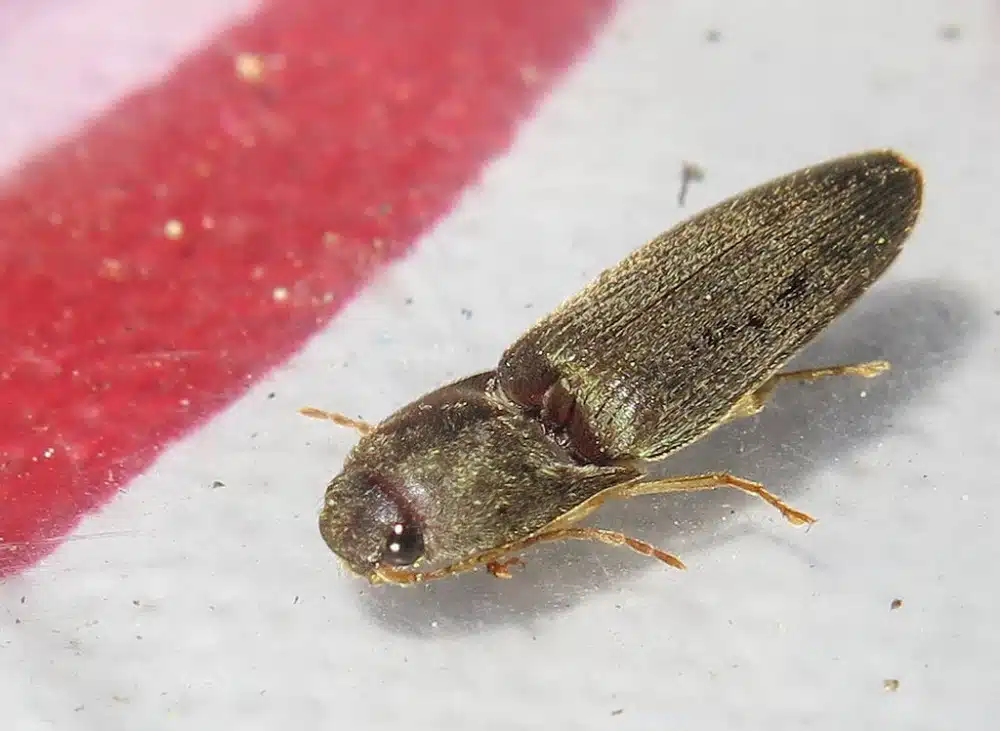
The Pasture Wireworm (Conoderus exsul) is also known as the sugarcane wireworm. It is a click beetle that grows to thirteen millimeters in length. They have pitted bodies in pale red or brown.
They have eleven segments on their antennae, the first segment is the longest. You will find the adult beetle on the surface of the soil, hiding in crevices around host plants. They remain hidden in the grass, under logs, and leaves. They are attracted by artificial light at night.
50. American Five-spotted Ladybug
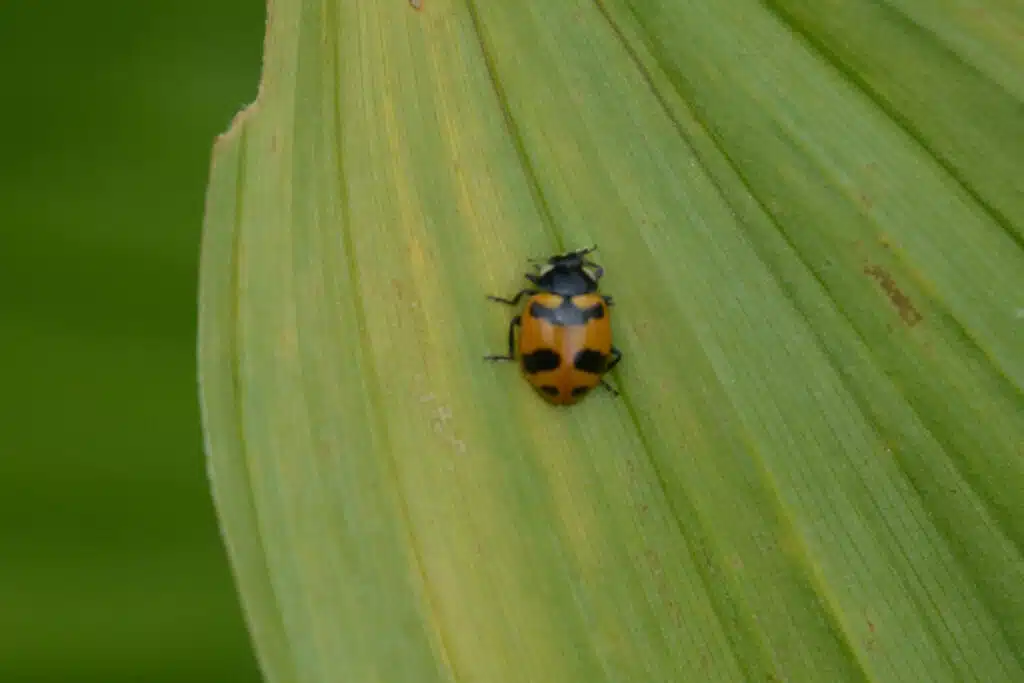
The American Five-spotted Ladybug (Hippodamia quinquesignata) is a common visitor in California gardens. They are oval-shaped and grow to eighteen millimeters. The back is dome-shaped and the underside is flat.
Females are larger than males. They have five pairs of spiracles on the abdomen. They are distinctive in color and pattern. Wing covers are light with dark spots. Some are dark with light spots. The light spots are red, orange, brown, or yellow.
Some species have checkered or striped patterns. The patterns and colors are a warning, warning predators that they are dangerous to eat. Their color also assists with camouflage.
51. Red Net-winged Beetle

The Red Net-winged Beetle (Dictyoptera simplicipes) is found in North America. They are cosmopolitan beetles, found on flowers or flower stems. Adult males can grow to fifteen millimeters in length with females being larger.
They feed on nectar and have short lifespans. They have triangular-shaped heads with long antennae. They are red protecting them from predators.
52. Western Banded Glowworm
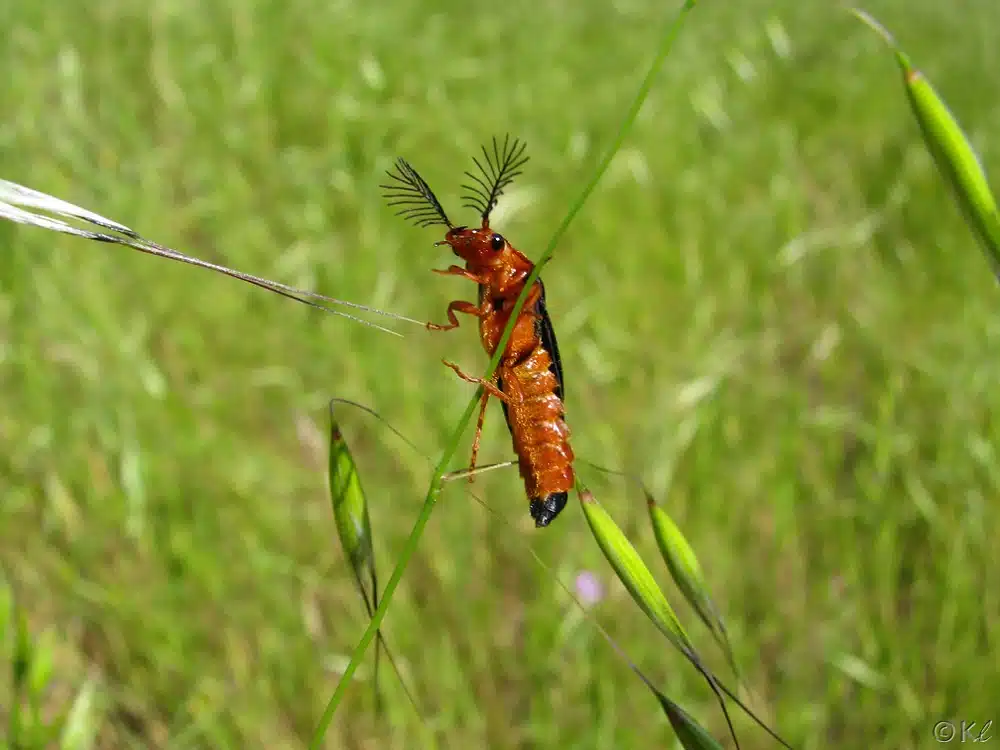
The Western Banded Glowworm (Zarhipis integripennis) is found throughout California. The larvae are known as glowworms. Both the females and larvae have bioluminescent organs. The males are winged and are attracted to artificial lighting at night.
Females are larger than males and remain in larva-form. Males can grow to twenty-three millimeters, whereas females are larger. They are common throughout California, predominantly in Baja California.
Larvae are active in January and February with adult males emerging from April to June. The larvae prey on millipedes.
53. Blue Dock Beetle

The Blue Dock Beetle (Gastrophysa cyanea) is a leaf beetle found in North America. They grow to five millimeters in length. Females can be distinguished by their swollen abdomens just before they lay eggs. They are common in spring.
The majority of these beetles are green, though some turn metallic blue. They are oblong-oval and shiny. The underside, legs, and antennae are black. The wing covers are rough and pitted.
This beetle is common in agricultural land and open areas where they feed on the dock from March to July.
54. California Pink Glowworm
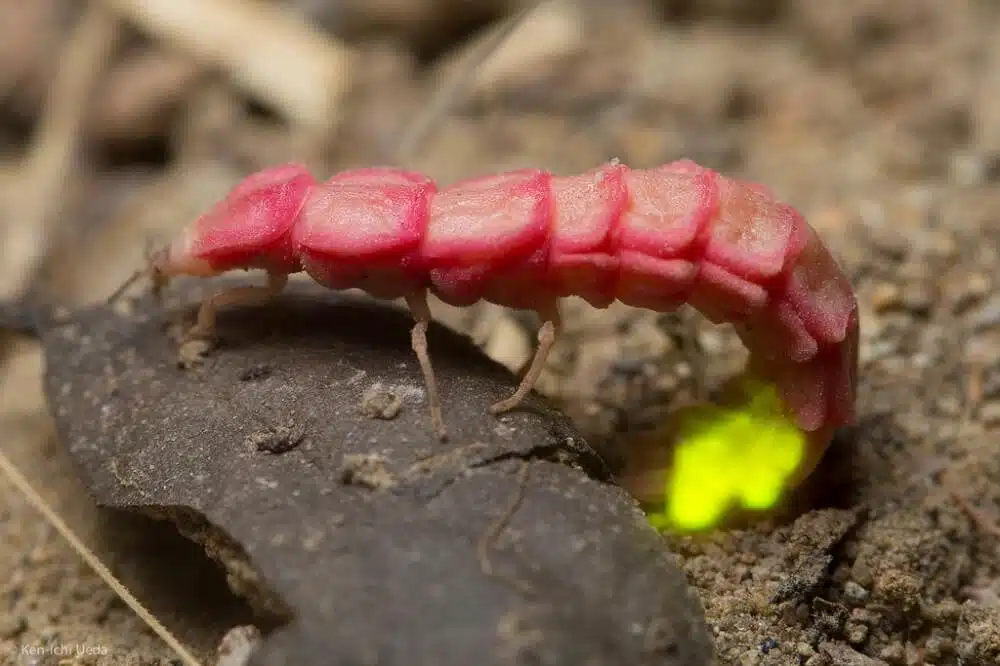
The California Pink Glowworm (Microphotus angustus) is a nocturnal beetle. The females remain in their larvae stage and never morph into winged beetles. Males morph into non-glowing winged beetles.
The female emits a steady and bright neon-green glow to attract a mate. The females have ten days of light-producing abilities. If the male does not find her before her light goes out, she dies without laying eggs.
Mated females lay eggs in the soil and under moist leaf litter. The larvae hatch and feed on soft-bodied invertebrates, including insect larvae, earthworms, and snails. They are common in oak woodland areas from spring to early summer.